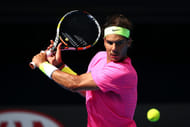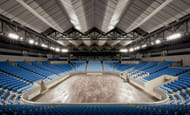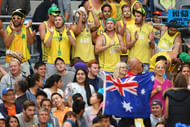After seven days of frenetic action spread across the dozens of tennis courts in Melbourne Park, we are now at the half-way mark of the 2015 Australian Open. The draws have now been whittled down to a quarter of their initial sizes, youngsters have risen, heroes have fallen, crowds have been in record attendance, and television ratings have gone through the roof; in other words, it has been a proper first week of a Grand Slam.
Personally, it has also been seven days of wandering around Melbourne Park, trying to take in as many of the sights and sounds as possible. So before the big guns are brought out on court for a mouth-watering second week of tennis contests, here are a few personal, and mostly irrelevant, observations about the year’s first Grand Slam.
The colour of the Open is blue
Not just any old blue, but the striking hurts-you-in-the-eye True Blue that is peculiar to the Australian Open. You encounter it even as you enter the main gates and step on to the Grand Slam Oval. On a clear summer day, the carpet under you can mirror the sky above, and have you struggling with a blue infinite horizon. Sunglasses are definitely recommended.
On the courts as well, the blue Plexipave surface provides a distinctive appearance. Emerging from the dark interiors of Rod Laver Arena for the first glimpse of Centre Court on a day session, the blue surface immediately hits you, and creates a theatrical ambience to the proceedings.
By all accounts though, the transition from green Rebound Ace to blue Plexipave at the 2008 tournament has been a successful one for players, spectators and TV audiences alike.
The stars shine bright
While on the subject of bright colours, the players themselves are determined not to be left behind. Every second player this year, both in the men’s and the women’s draw, has been decked in a garish outfit of some fluorescent form or the other. The bright neon shades have lent a party atmosphere to what is already called the ‘Friendly Slam’.
Obviously, the big sponsors like Nike have had something to do with this. Identical flowing-pink fluorescent outfits have been adorned by a number of the ladies to varying degrees of success, including Kvitova, Lisicki, Errani and Martic. The only problem with this has been the effort needed to distinguish between similarly-decked players slugging it out on a crowded outside crowd.
Serena Williams, always the fashionista, has been making waves with a dashing backless yellow-and-pink outfit.
The men have not been shy of making a fashion statement either. Whether it is the young upstarts in Tomic and Kokkinakkis or the big guns in Federer and Nadal, everyone seems intent on outdoing the others in dressing the loudest. But somehow, the bright traffic lights of the outfits seems to go well with the overall mood of the tournament. Maybe it is just the bright summer sun or the contrast of the blue tennis courts, but neon seems the way to go.
As Nadal himself replied on being asked about the reflector lights on his shorts, “Well, I think Australia is the right place to wear it.” Of course, Rafa, you couldn’t pull this off in Wimbledon now, could you?
Three courts, three roofs
As the tournament organisers and local press keep insisting on letting everyone know, the Australian Open is now the only Major among the four Grand Slams that can boast of three courts with retractable roofs. This laudable feat was achieved with the introduction of a roof over the Margaret Court Arena last year. Unfortunately, or perhaps fortunately, we have not yet been able to test the working of the new roof in this tournament. And given the good forecast over the second week, chances are that the Margaret Court Arena will not get to host an indoor tennis match until at least 2016.
In spite of missing out on the experience of watching a roof close in overhead, my personal favourite court has to be the Margaret Court Arena. It is the most intimate of big courts, with a seating capacity of around 7,500. It provides the grand ambience required for a high-profile match, while at the same time allowing spectators to feel directly connected to proceedings in the centre. Add in some top-notch facilities and ease of access, and you have a truly world-class stadium.
Rod Laver Arena is actually just as good, but seats more people at 15,000. In a way, its virtue becomes its weakness, but this is only in comparison to Margaret Court next door. The best thing about the Rod Laver Arena has to be its egalitarian seating arrangements. For a centre court in a Grand Slam tournament, it is refreshingly free of corporate boxes, sponsor tiers, and even player boxes. As a result, you can easily end up brushing shoulders with Mirka Federer or Patrick Mouratoglou. Every seat in the house is a good one, and everyone has access to it.
Hisense Arena, however, is in stark contrast to the other two show courts. Here, the environment is almost industrial, with high ceilings, grey interiors, aluminium-like fittings, and steeply inclined seating. The place feels too big and empty to create the right kind of atmosphere for a high-voltage tennis match. Perhaps it might be different with the roof closed. Oh, for some rain to descend over the next few days!
Cheers for the cheering squads
An important aspect of the Australian Open experience is, undeniably, the fan support. The average Melbourne local you meet on the street tends to have an opinion on Nick Kyrgios and Roger Federer. These people have enthusiastically filled the stands this past week, both on the show courts and the outside courts, extending support to stars and journeymen alike.
Then, we have the individual fan squads to add colour to the proceedings. The most noticeable are possibly the Aussie Fanatics, all in yellow and crying out, “Aussie, Aussie, Aussie! Oi! Oi! Oi!”. They have had good reason to cheer this week, with the local players putting up some solid performances.
Then there’s the Genie Army, who Eugenie Bouchard asked to “learn some new tunes”, and also Andy Murray’s squad, who “my Mom always tries to arrange tickets for”. And of course, there is the football-like Melbourne cheering team for Marcos Baghdatis. They made as much an impact on proceedings as Baghdatis did, in his last match against Dimitrov.
My personal favourite has to be Murray’s fan team. They are a small bunch of guys, but their repertoire is vast and their execution impeccable. It doesn’t hurt that they can actually hold a tune as well.
An organized tournament is a happy tournament
Being part of a tournament of the scale of the Australian Open exposes you to the numerous complexities involved in its back-stage management. There are players who need to be pampered, media who need to be addressed, and spectators who need to be kept satisfied, all at the same time. There are people running around with different access passes, reporting to different teams, executing different activities, hoping they all come together to provide a seamless experience.
In reality, it does. Ignoring the odd hiccup or inconvenience, the event is an achievement in logistics and coordination. But that is to be expected, you might say, with the vast experience gathered over so many years in conducting a premium event like a Grand Slam. And while that may be true, what does impress is the attention to detail and the personal involvement everyone seems to have.
Providing additional tram services from the city to Melbourne Park may be the expected thing to do, but having a recorded message from Todd Woodbridge welcoming commuters on the tram to the Australian Open is a nice, personal touch. Water fountains in the grounds for particularly hot days is only the right step, but moving in water vapour fans for spectators to soak in, is taking comfort to the next fun level.
Each individual involved in the entire management of the tournament seems to play his part with a smile, however small his role might be. It could be the security guard checking your bags at the entrance, the media coordinator who welcomes you at the reception desk, or the linesman who has just finished a shift on the courts. Everyone is happy to talk about tennis, and seems aware of the bigger picture.
There is a sense of pride and happiness in being associated with Australia’s Grand Slam. And because of that, this is not the ‘Happy Slam’ for just the players alone, but for everyone involved in it.
Who Are Roger Federer's Kids? Know All About Federer's Twins



